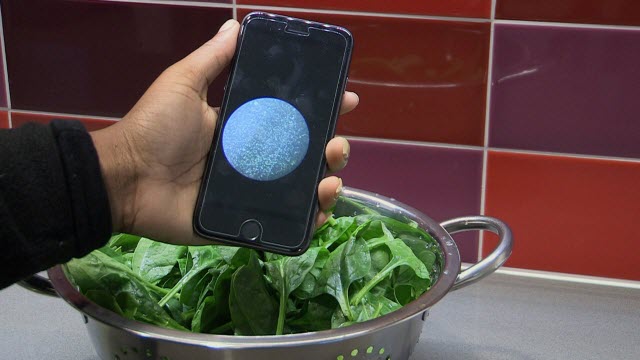Food Scientists Are Developing a Low-Cost Tool for Detecting Bacteria in Food, Water
Food scientist Lili He and colleagues at the University of Massachusetts Amherst report that they have developed a new, rapid and low-cost method for detecting bacteria in water or a food sample
 The optical detection method was adapted for possible home use with a smartphone microscope adapter that is widely available online for about $30.Photo credit: UMass Amherst
The optical detection method was adapted for possible home use with a smartphone microscope adapter that is widely available online for about $30.Photo credit: UMass Amherst
AMHERST, Mass. — Food scientist Lili He and colleagues at the University of Massachusetts Amherst report that they have developed a new, rapid and low-cost method for detecting bacteria in water or a food sample. Once commercially available, it should be useful to cooks using fresh fruits and vegetables, for example, and aid workers in the field responding to natural disasters, He says.
An analytical chemist and expert in detection methods for food contamination, He says, "Most people around the world cook their vegetables before eating, but here in the U.S. more and more people like to eat these foods raw. This gave us the idea that a quick test that can be done at home would be a good idea."
Related Article: New "Sugar-Glass" Film Uses Viruses to Kill Harmful Bacteria in Food
She adds, "Microbial contamination is an important research topic right now. "It has been a problem for a long time, but it is now the number one concern for food safety in the U.S."
 Food scientist Lili He and colleagues have designed a sensitive and reliable bacteria-detecting chip that can test whether fresh spinach or apple juice, for example, carry a bacterial load.Photo credit: UMass AmherstHe, with fellow food science researcher Lynne McLandsborough and their students, in particular first author Brooke Pearson, reported on their new two-step method —one optical, one chemical—in two papers this year, one in a recent early online issue of Food Microbiology scheduled for publication in 2018, and an earlier one in the Royal Society of Chemistry's journal, Analytical Methods.
Food scientist Lili He and colleagues have designed a sensitive and reliable bacteria-detecting chip that can test whether fresh spinach or apple juice, for example, carry a bacterial load.Photo credit: UMass AmherstHe, with fellow food science researcher Lynne McLandsborough and their students, in particular first author Brooke Pearson, reported on their new two-step method —one optical, one chemical—in two papers this year, one in a recent early online issue of Food Microbiology scheduled for publication in 2018, and an earlier one in the Royal Society of Chemistry's journal, Analytical Methods.
For this work, they designed a sensitive and reliable bacteria-detecting chip that can test whether fresh spinach or apple juice, for example, carry a bacterial load. The chip, used with a light microscope for optical detection, relies on what He calls a "capture molecule," 3-mercaptophenylboronic acid (3-MBPA) that attracts and binds to any bacteria. The chemical detection method, "surface-enhanced Raman spectroscopy" (SERS), relies on silver nanoparticles. The techniques are now in the patenting process.
Over the past summer, the optical detection method was adapted for possible home use with a smartphone microscope adapter that is widely available online for about $30. The first step in the new test for bacteria detection is to collect a sample of water, juice, or mashed vegetable leaf and place the chemical-based detection chip in with the sample. A summer high school student in He's food science laboratory developed a simple smartphone app that visually detects bacteria in samples that contain the chip. "This is just the beginning of the work," says He. She hopes to receive more funding to continue this practical application.
The standard method for culturing bacteria from food samples, known as an aerobic plate count (APC) takes two days, He explains. "There are some others that are faster, but they are not very sensitive or reliable because ingredients in the food can interfere with them. We show in our most recent paper that our method is both sensitive and reliable and it can give you results in less than two hours."
To address the food interference problem, the researchers designed the UMass Amherst chip to attract only bacteria but not sugars, fats, and proteins in food or dirt. The food compounds can be washed away with a high-pH buffer, the food chemist says, leaving only bacteria for visual counting with the smartphone microscope and app. This method can detect as few as 100 bacteria cells per 1 milliliter of solution, compared to a sensitivity of 10,000 cells for other rapid methods.
In their recent study, He and colleagues explored "the advantages and constraints of this assay over the conventional APC method and further developed methods for detection in real environmental and food matrices," the authors explain. "This study advanced the SERS technique for real applications in environment and food matrices," they point out.
